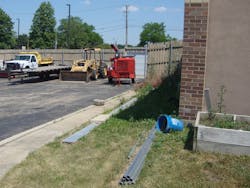Editor’s note: “Mitigating Mistakes” is a monthly SecurityInfoWatch.com column series from security consultant and author Paul Timm featuring photos of security vulnerabilities discovered in the field followed by a discussion on the problems they present to a facility’s security posture and how they can be addressed.
Finding: While conducting security assessments, I often encounter debris along the building perimeter. Typical items that can be categorized as debris include wood pallets, bricks/rocks, empty containers, and scrap metal.
Problem: Debris is either comprised of materials that have value and can be salvaged for specific uses or it lacks value and can be considered “garbage.” Unsecured materials that have value can be stolen or damaged. Materials that lack value run the risk of being used in acts of vandalism and other criminal activities.
Lesson: In Crime Prevention Through Environmental Design (CPTED), the principle of “maintenance” speaks to the need to furnish an environment that is neat, clean and orderly. A poorly maintained property attracts criminal activity. In fact, CPTED’s "Broken Windows Theory" states that visible signs of disorder (e.g. broken windows left in disrepair) encourage further and potentially increasing levels of crime and disorder.
Remedy: Clean up your perimeter debris. If those materials have value, store them in a secured area. If they have no value, take steps toward proper disposal or recycling. Either way, time is of the essence. Get started today.
About the Author:
Paul Timm, Vice President of Facility Engineering Associates, is a board-certified Physical Security Professional (PSP), the author of School Security: How to Build and Strengthen a School Safety Program, and a nationally acclaimed expert in physical security. In addition to conducting numerous vulnerability assessments and his frequent keynote addresses, Paul is an experienced Crisis Assistance Team volunteer through the National Organization for Victims Assistance (NOVA). He is certified in Vulnerability Assessment Methodology (VAM) through Sandia National Laboratories and the ALPHA vulnerability assessment methodology. He is also a member of ASIS International’s School Safety & Security Council and the Illinois Association of School Business Officials’ Risk Management Committee. Paul recently earned his Master’s degree from Moody Theological Seminary.
About the Author

Paul Timm, PSP
President, RETA Security, Inc.
Paul Timm, Vice President of Facility Engineering Associates, is a board-certified Physical Security Professional (PSP), the author of School Security: How to Build and Strengthen a School Safety Program, and a nationally acclaimed expert in physical security. In addition to conducting numerous vulnerability assessments and his frequent keynote addresses, Paul is an experienced Crisis Assistance Team volunteer through the National Organization for Victims Assistance (NOVA). He is certified in Vulnerability Assessment Methodology (VAM) through Sandia National Laboratories and the ALPHA vulnerability assessment methodology. He is also a member of ASIS International’s School Safety & Security Council and the Illinois Association of School Business Officials’ Risk Management Committee. Paul recently earned his Master’s degree from Moody Theological Seminary.
